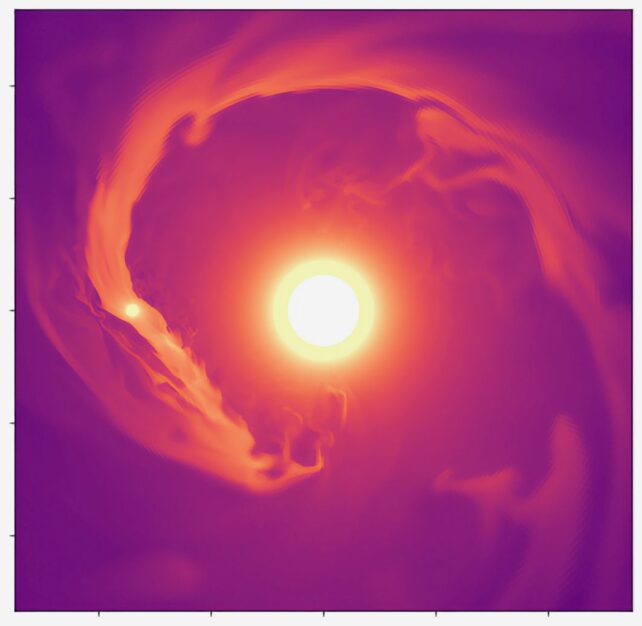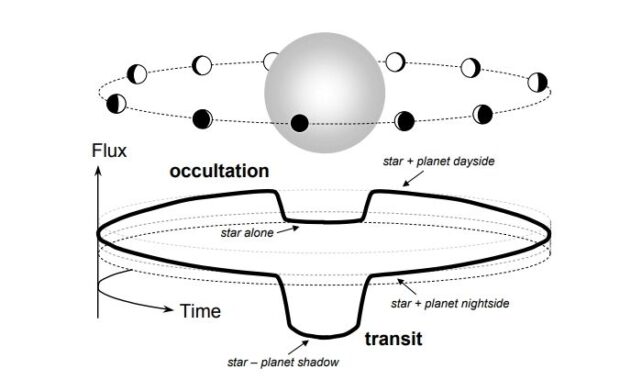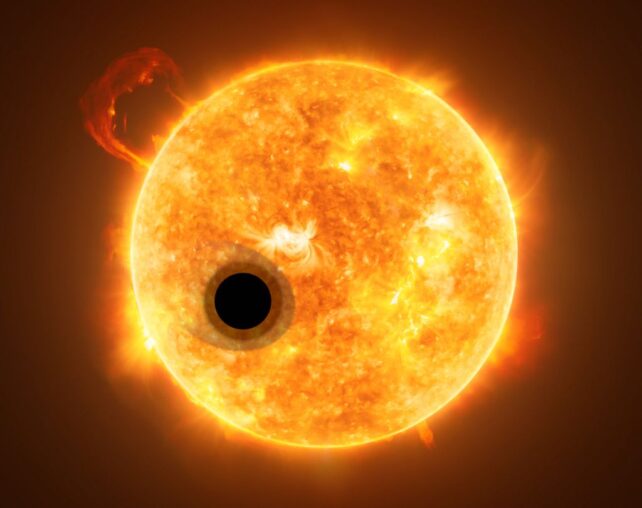If a planet has an atmosphere, it's probably leaking, some faster than others. And astronomers have just found a hum-dinger: an atmosphere so leaky it's spurting out in giant jets.
The exoplanet responsible for this activity is HAT-P-32b, a gas giant some 1.8 times the radius of Jupiter, around 923 light-years away. It's spitting out enough gas to form two tails, together spanning a distance greater than 53 times the exoplanet's radius.
According to a team led by astrophysicist Zhoujian Zhang of the University of California, Santa Cruz, these tails are among the largest structures we've ever found associated with an exoplanet.

"It is exciting to see how gigantic the extended tails are compared to the size of the planet and its host star," says Zhang, who led the discovery while at the University of Texas at Austin. "Other planets might also have extended escaping atmospheres waiting to be discovered through similar monitoring."
That HAT-P-32b is losing its atmosphere is not unexpected. It's a puffy world with a low density, just 10 percent that of Jupiter's, orbiting its star on a very close orbit of just 2.15 days. At that proximity to its star – one that's a little bigger and hotter than the Sun – the exoplanet is heated to a temperature of around 1,836 Kelvin (2,845 Fahrenheit, 1,562 Celsius).
The heat makes HAT-P-32b so puffy, but it's also what's stripping away its atmosphere. Previous observations noted this effect in action but had not captured the true extent of the atmospheric destruction wrought by the star.

That's because we study HAT-P-32b using transits, which is when an exoplanet orbits between us and its star. This causes the star's light to fluctuate slightly on a regular basis, dimming when the exoplanet blocks some of its light.
But something interesting happens when an exoplanet with an atmosphere passes in front of its host star. Some of that star's light travels through the atmosphere, causing changes to the spectrum as some wavelengths are absorbed and re-emitted by elements and compounds in the gas. These can be picked out and traced to the substances causing them, like a chemical fingerprint.
HAT-P-32b's leaky atmosphere became apparent from observations of these transits when scientists noticed an excess of hydrogen alpha and helium. Because they only looked at transit data, we didn't know the full extent of the leak.
Zhang and his colleagues used the Hobby-Eberly Telescope at the McDonald Observatory in Texas to observe the exoplanet over the course of several nights, to piece together data covering its complete orbit, not just the 3 hours it takes to transit. Then, they carefully analyzed the spectra, looking for variations in the gasses known to be leaking from HAT-P-32b's atmosphere.

They found that the tails are absolutely massive. The exoplanet is puffing up so much that it's spilling over the point at which the gas can remain gravitationally bound to the planet, ejecting vast amounts of material out into the space around the star – around 33.8 trillion tons per year, according to the team's calculations.
At that rate, it will take the world's atmosphere around 40 billion years to evaporate entirely. That is a long time – almost triple the current lifespan of the Universe of 13.8 billion years – and could help astronomers interpret other leaky gas exoplanets on close orbits with their stars.
"Our findings on HAT-P-32b may help us understand how other planets and their stars interact," says astronomer Caroline Morley of the University of Texas at Austin. "We are able to take high-precision measurements on hot Jupiters, like this one, and then apply our findings to a wider range of planets."
We've found leaky exoplanets before, and some even share some similarities with the transits of HAT-P-32b. The discovery suggests that many more of these giant tails may be out there, just waiting for us to look.
The research has been published in Science Advances.
